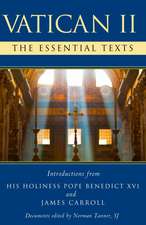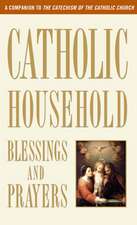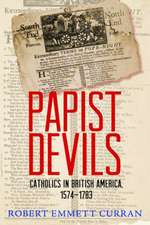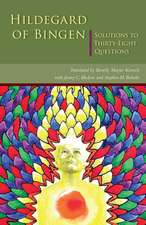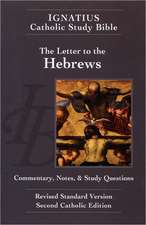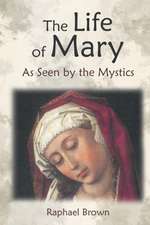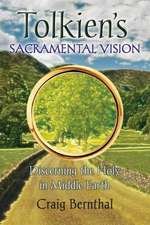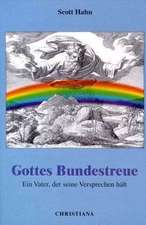Jesus and the Jewish Roots of the Eucharist: Unlocking the Secrets of the Last Supper
Autor Brant Pitre Scott Hahnen Limba Engleză Paperback – feb 2016
Jesus and the Jewish Roots of the Eucharist shines fresh light on the Last Supper by looking at it through Jewish eyes. Using his in-depth knowledge of the Bible and ancient Judaism, Dr. Brant Pitre answers questions such as: What was the Passover like at the time of Jesus? What were the Jewish hopes for the Messiah? What was Jesus’ purpose in instituting the Eucharist during the feast of Passover? And, most important of all, what did Jesus mean when he said, “This is my body… This is my blood”?
To answer these questions, Pitre explores ancient Jewish beliefs about the Passover of the Messiah, the miraculous Manna from heaven, and the mysterious Bread of the Presence. As he shows, these three keys—the Passover, the Manna, and the Bread of the Presence—have the power to unlock the original meaning of the Eucharistic words of Jesus. Along the way, Pitre also explains how Jesus united the Last Supper to his death on Good Friday and his Resurrection on Easter Sunday.
Inspiring and informative, Jesus and the Jewish Roots of the Eucharist is a groundbreaking work that is sure to illuminate one of the greatest mysteries of the Christian faith: the mystery of Jesus’ presence in “the breaking of the bread.”
From the Hardcover edition.
| Toate formatele și edițiile | Preț | Express |
|---|---|---|
| Paperback (1) | 95.70 lei 3-5 săpt. | |
| IMAGE – feb 2016 | 95.70 lei 3-5 săpt. | |
| Hardback (1) | 135.50 lei 3-5 săpt. | |
| Doubleday Religion – 31 ian 2011 | 135.50 lei 3-5 săpt. |
Preț: 95.70 lei
Nou
Puncte Express: 144
Preț estimativ în valută:
18.31€ • 19.17$ • 15.24£
18.31€ • 19.17$ • 15.24£
Carte disponibilă
Livrare economică 10-24 martie
Preluare comenzi: 021 569.72.76
Specificații
ISBN-13: 9780385531863
ISBN-10: 0385531869
Pagini: 256
Dimensiuni: 130 x 203 x 18 mm
Greutate: 0.23 kg
Editura: IMAGE
ISBN-10: 0385531869
Pagini: 256
Dimensiuni: 130 x 203 x 18 mm
Greutate: 0.23 kg
Editura: IMAGE
Recenzii
“In the Mass ߝ in the 'blood of the new and everlasting covenant' ߝ Christ fulfills the rites of the old covenant. This beautiful book by Dr. Brant Pitre shows us that fulfillment in loving detail. We gain an appreciation of what was, so that we can see, ever more clearly, what 'is now and ever shall be.' Clear, profound and practical ߝ you do not want to miss this book.”
ߝ Dr. Scott Hahn, author of The Lamb’s Supper and Signs of Life
“In Jesus and the Jewish Roots of the Eucharist Brant Pitre pairs together the Jewish Scriptures and the Jewish tradition to frame the actions of Jesus at the Last Supper, and to provide a fresh look at the heart of Christian practice—the Eucharist. By taking us back to the Jewish roots of our faith, Pitre gives us a powerful lens through which to see anew the bread of the presence, the manna, the Last Supper, and ultimately the meaning of Christian Eucharist. Pitre’s mastery of Scripture and the Jewish traditions makes him the perfect guide for anyone seeking to understand the climax of Jesus’ ministry, the Last Supper and the first Eucharist.”
ߝ Dr. Tim Gray, President of the Augustine Institute
“For Christians, it is impossible to understand ourselves apart from Christ. And here, we see how we cannot truly realize the richness of the Eucharist apart from its meaning in light of the Jewish covenant with God. What an exquisite view of the Eucharist as a personal encounter with Christ and the first Eucharist as a humanity-wide encounter with God!”
ߝ Carl A. Anderson, Supreme Knight of the Knights of Columbus and the New York Times bestselling author of Our Lady of Guadalupe
“With Jesus and the Jewish Roots of the Eucharist Brant Pitre puts the Eucharistic Christ into thrilling context by examining the realities of Jewish life in the first century. Believers and non-believers alike will better-appreciate the rich cultural, traditional and scriptural wells from which Eucharistic understanding has been drawn and developed since Jesus of Nazareth first proclaimed, ‘my flesh is real food, and my body real drink.’”
ߝ Elizabeth Scalia, Managing Editor (Catholic) at Patheos.com and the blogger known as The Anchoress
“Captivating, clear and compelling, this book shows how the Eucharist is at the heart of Jesus’ messianic mission. After guiding readers through ancient Jewish hopes for a new Exodus, a new Passover, a new manna and a new temple, Pitre demonstrates step-by-step how Jesus’ institution of the Eucharist fulfills those eschatological expectations. This book is a must read for anyone studying the Biblical foundations for the Eucharist.”
ߝ Edward Sri, Provost of the Augustine Institute and author of Men, Women and the Mystery of Love
“Rare is the book that demands to be read by beginners and scholars alike, but Brant Pitre has written such a book, combining sparkling prose with profound insight into Scripture's meanings and contexts. Guided by Pitre, we enter into the ancient Israelite prophetic expectation of the fulfillment of the original Exodus through a new Passover, new manna, new priest-king, and new Temple. Pitre shows us how age-old controversies over the Eucharist as sacrifice, meal, and real presence are illumined by Jesus in the Gospels. This exciting and inspiring book fills a major gap in biblical studies.”
ߝ Matthew Levering, Professor of Theology, University of Dayton, and author of Sacrifice and Community: Jewish Offering and Christian Eucharist
From the Hardcover edition.
ߝ Dr. Scott Hahn, author of The Lamb’s Supper and Signs of Life
“In Jesus and the Jewish Roots of the Eucharist Brant Pitre pairs together the Jewish Scriptures and the Jewish tradition to frame the actions of Jesus at the Last Supper, and to provide a fresh look at the heart of Christian practice—the Eucharist. By taking us back to the Jewish roots of our faith, Pitre gives us a powerful lens through which to see anew the bread of the presence, the manna, the Last Supper, and ultimately the meaning of Christian Eucharist. Pitre’s mastery of Scripture and the Jewish traditions makes him the perfect guide for anyone seeking to understand the climax of Jesus’ ministry, the Last Supper and the first Eucharist.”
ߝ Dr. Tim Gray, President of the Augustine Institute
“For Christians, it is impossible to understand ourselves apart from Christ. And here, we see how we cannot truly realize the richness of the Eucharist apart from its meaning in light of the Jewish covenant with God. What an exquisite view of the Eucharist as a personal encounter with Christ and the first Eucharist as a humanity-wide encounter with God!”
ߝ Carl A. Anderson, Supreme Knight of the Knights of Columbus and the New York Times bestselling author of Our Lady of Guadalupe
“With Jesus and the Jewish Roots of the Eucharist Brant Pitre puts the Eucharistic Christ into thrilling context by examining the realities of Jewish life in the first century. Believers and non-believers alike will better-appreciate the rich cultural, traditional and scriptural wells from which Eucharistic understanding has been drawn and developed since Jesus of Nazareth first proclaimed, ‘my flesh is real food, and my body real drink.’”
ߝ Elizabeth Scalia, Managing Editor (Catholic) at Patheos.com and the blogger known as The Anchoress
“Captivating, clear and compelling, this book shows how the Eucharist is at the heart of Jesus’ messianic mission. After guiding readers through ancient Jewish hopes for a new Exodus, a new Passover, a new manna and a new temple, Pitre demonstrates step-by-step how Jesus’ institution of the Eucharist fulfills those eschatological expectations. This book is a must read for anyone studying the Biblical foundations for the Eucharist.”
ߝ Edward Sri, Provost of the Augustine Institute and author of Men, Women and the Mystery of Love
“Rare is the book that demands to be read by beginners and scholars alike, but Brant Pitre has written such a book, combining sparkling prose with profound insight into Scripture's meanings and contexts. Guided by Pitre, we enter into the ancient Israelite prophetic expectation of the fulfillment of the original Exodus through a new Passover, new manna, new priest-king, and new Temple. Pitre shows us how age-old controversies over the Eucharist as sacrifice, meal, and real presence are illumined by Jesus in the Gospels. This exciting and inspiring book fills a major gap in biblical studies.”
ߝ Matthew Levering, Professor of Theology, University of Dayton, and author of Sacrifice and Community: Jewish Offering and Christian Eucharist
From the Hardcover edition.
Extras
Chapter 1
The Mystery of the Last Super
Jesus and Judaism
Jesus of Nazareth was a Jew. He was born of a Jewish mother, received the Jewish sign of circumcision, and grew up in a Jewish town in Galilee. As a young man, he studied the Jewish Torah, celebrated Jewish feasts and holy days, and went on pilgrimages to the Jewish Temple. And, when he was thirty years old, he began to preach in the Jewish synagogues about the fulfillment of the Jewish Scriptures, proclaiming the kingdom of God to the Jewish people. At the very end of his life, he celebrated the Jewish Passover, was tried by the Jewish council of priests and elders known as the Sanhedrin, and was crucified outside the great Jewish city of Jerusalem. Above his head hung a placard that read in Greek, Latin, and Hebrew: "Jesus of Nazareth, King of the Jews" (John 19:19).
As this list demonstrates, the Jewishness of Jesus is a historical fact. But is it important? If Jesus was a real person who really lived in history, then the answer must be "Yes." To be sure, over the centuries, Christian theologians have written books about Jesus that don't spend much time studying his Jewish context. Much of the effort has gone into exploring the question of his divine identity. However, for anyone interested in exploring the humanity of Jesus-especially the original meaning of his words and actions-a focus on his Jewish identity is absolutely necessary. Jesus was a historical figure, living in a particular time and place. Therefore, any attempt to understand his words and deeds must reckon with the fact that Jesus lived in an ancient Jewish context. Although on a few occasions Jesus welcomed non-Jews (Gentiles) who accepted him as Messiah, he himself declared that he had been sent first and foremost "to the lost sheep of the house of Israel" (Matthew 10:5). This means that virtually all of his teachings were directed to a Jewish audience in a Jewish setting.
For instance, during his first sermon in his hometown synagogue at Nazareth, Jesus began to reveal his messianic identity in a very Jewish way. He did not shout aloud in the streets or cry out from the rooftops, "I am the Messiah." Instead, he took up the scroll of the prophet Isaiah and found the place that spoke of the coming of an "anointed" deliverer (see Isaiah 61:1-4). After reading Isaiah's prophecy, Jesus closed the scroll and said to his audience, "Today, this scripture has been fulfilled in your hearing" (Luke 4:21). With these words, he proclaimed to his fellow Jews that their long-held hope for the coming of the Messiah, the "anointed one" (Hebrew mashiah), had at last been fulfilled-in him. As we will see over the course of this book, this was the first of many instances in which Jesus would utilize the Jewish Scriptures to reveal himself to a Jewish audience as the long-awaited Jewish Messiah.
You Shall Not Drink the Blood
However, if Jesus did in fact see himself as the Jewish Messiah, then we are faced with a historical puzzle-a mystery of sorts. On the one hand, Jesus drew directly on the Jewish Scriptures as the inspiration for many of his most famous teachings. (Think once again of his sermon in the synagogue at Nazareth.) On the other hand, he said things that appeared to go directly against the Jewish Scriptures. Perhaps the most shocking of these are his teachings about eating his flesh and drinking his blood. According to the Gospel of John, in another Jewish synagogue on another Sabbath day, Jesus said the following words:
"Amen, amen, I say to you, unless you eat the flesh of the Son of Man and drink his blood, you have no life in you; he who eats my flesh and drinks my blood has eternal life, and I will raise him up at the last day. For my flesh is food indeed, and my blood is drink indeed . . ." This he said in the synagogue, as he taught at Capernaum. (john 6:53-54, 59)
And then again, at the Last Supper, on the night he was betrayed:
Now, as they were eating, Jesus took bread, and blessed, and broke it, and gave it to the disciples and said, "Take, eat; this is my body." And he took a cup, and when he had given thanks he gave it to them, saying, "Drink of it, all of you; for this is my blood of the covenant, which is poured out for many for the forgiveness of sins." (matthew 26:26-28)
What is the meaning of these strange words? What did Jesus mean when he told his Jewish listeners in the synagogue that they had to eat his flesh and drink his blood in order to have eternal life? And what did he mean when he told his Jewish disciples that the bread of the Last Supper was his "body" and the wine was his "blood"? Why did he command them to eat and drink it?
We'll explore these questions and many others throughout this book. For now, I simply want to point out that the history of Christianity reveals dozens of different responses. Over the centuries, most Christians have taken Jesus at his word, believing that the bread and wine of the Eucharist really do become the body and blood of Christ. Others, however, especially since the time of the Protestant Reformation in the 1500s, think that Jesus was speaking only symbolically. Still others, such as certain modern historians, deny that Jesus could have said such things, even though they are recorded in all four Gospels and in the writings of Saint Paul (see Matthew 26:26-29; Mark 14:22-25; Luke 22:14-30; John 6:53-58; 1 Corinthians 11:23-26).
The reasons for disagreement are several. First of all is the shocking nature of Jesus' words. How could anyone, even the Messiah, command his followers to eat his flesh and drink his blood? As the Gospel of John records, when Jesus' disciples first heard his teaching, they said, "This is a hard saying, who can listen to it?" (John 6:60). Jesus' words were so offensive to their ears that they could barely listen to him. And indeed, many of them left him, and "no longer walked with him" (John 6:66). And he let them go. From the very beginning, people found Jesus' command to eat his body and drink his blood extremely offensive.
Another reason for disagreement is somewhat more subtle. Even if Jesus was speaking literally about eating his flesh and drinking his blood, what could such a command even mean? Was he talking about cannibalism-eating the flesh of a human corpse? While there is no explicit commandment against cannibalism in the Jewish Bible, it was certainly considered taboo. Again, the Gospels bear witness to this reaction. "The Jews then disputed among themselves, saying, 'How can this man give us his flesh to eat?'" (John 6:52). This is a good question, and it deserves a good answer.
Perhaps the strongest objection to Jesus' words comes from Jewish Scripture itself. As any ancient Jew would have known, the Bible absolutely forbids a Jewish person to drink the blood of an animal. Although many Gentile religions considered drinking blood to be a perfectly acceptable part of pagan worship, the Law of Moses specifically prohibited it. God had made this very clear on several different occasions. Take, for example, the following Scriptures:
Every moving thing that lives shall be food for you. . . . Only you shall not eat flesh with its life, that is, its blood. (genesis 9:3-4)
If any man of the house of Israel or of the strangers that sojourns among them eats any blood, I will set my face against that person who eats blood, and will cut him off from among his people. For the life of the flesh is in the blood; and I have given it for you upon the altar to make atonement for your souls; for it is the blood that makes atonement, by reason of its life. Therefore I have said to the people of Israel, No person among you shall eat blood, neither shall any stranger who sojourns among you eat blood. (leviticus 17:10-12)
You may slaughter and eat flesh within any of your towns, as much as you desire. . . . Only you shall not eat the blood; you shall pour it out upon the earth like water. (deuteronomy 12:16)
Clearly, the commandment against drinking animal blood was serious. To break it would mean being "cut off" from God and from his people. Notice also that it was a universal law. God expected not only the chosen people of Israel to keep it, but any Gentile "strangers" living among them. Finally, note the reason for the prohibition. People were not to consume blood because "the life" or "the soul" (Hebrew nephesh) of the animal is in the blood. As Leviticus states, "It is the blood that makes atonement, by the power of its life." While scholars continue to debate exactly what this means, one thing is clear: in the ancient world, the Jewish people were known for their refusal to consume blood. Jesus' words at the Last Supper become even more mysterious with this biblical background in mind. As a Jew, how could he ever have commanded his disciples to eat his flesh and drink his blood? Wouldn't this mean explicitly breaking the biblical law against consuming blood? Indeed, even if Jesus meant his words only symbolically, how could he say such things? Wouldn't his command mean transgressing the spirit of the Law, if not the letter? As the Jewish scholar Geza Vermes points out,
[T]he imagery of eating a man's body and especially drinking his blood . . . , even after allowance is made for metaphorical language, strikes a totally foreign note in a Palestinian Jewish cultural setting (cf. John 6.52). With their profoundly rooted blood taboo, Jesus' listeners would have been overcome with nausea at hearing such words.
So, what should we make of these words of Jesus?
Through Ancient Jewish Eyes
In this book, I will try to show that Jesus should be taken at his word. Along with the majority of Christians throughout history, I believe that Jesus himself taught that he was really and truly present in the Eucharist. In doing so, I will follow the Apostle Paul, a first-century Pharisee and an expert in the Jewish Law, when he said,
I speak as to sensible men, judge for yourselves what I say. The cup of blessing which we bless, is it not a communion in the blood of Christ? The bread which we break, is it not a communion in the body of Christ? (1 corinthians 10:16)
My goal is to explain how a first-century Jew like Jesus, Paul, or any of the apostles, could go from believing that drinking any blood-much less human blood-was an abomination before God, to believing that drinking the blood of Jesus was actually necessary for Christians: "Unless you eat the flesh of the Son of Man and drink his blood, you have no life in you" (John 6:53).
In order to achieve this goal, we will have to go back in time to the first century A.D., in order to understand what Jesus was doing and saying in his original context. To a certain extent, this will mean taking off our modern "eyeglasses" and trying to see things as the first Jewish Christians saw them. When we look at the mystery of the Last Supper through ancient Jewish eyes, in the light of Jewish worship, beliefs, and hopes for the future, we will discover something remarkable. We will discover that there is much more in common between ancient Judaism and early Christianity than we might at first have expected. In fact, we will find that it was precisely the Jewish faith of the first Christians that enabled them to believe that the bread and wine of the Eucharist were really the body and blood of Jesus Christ.
Unfortunately, as soon as we try to do this, we are faced with a problem. In order for us to hear Jesus in the way his first disciples would have heard him, we need to be familiar with two key sources of information: (1) the Jewish Scriptures, commonly known as the Old Testament, and (2) ancient Jewish tradition, enshrined in writings not contained in the Jewish Bible.
Now, if my experience with students is any indicator, many modern readers-especially Christians-find the Jewish Scriptures to be challenging and unfamiliar territory. This is especially true of those passages in the Old Testament that describe ancient Jewish rituals, sacrifice, and worship-passages that will be very important for us as we explore Jesus' last meal with his friends before his crucifixion. As for ancient Jewish writings outside the Bible-such as the Mishnah and the Talmud-although many people have heard of them, they are often not widely read by non-Jewish readers aside from specialists in biblical studies.
For this reason, before beginning, it will be helpful to briefly identify the Jewish writings that I will be drawing on over the course of this book. (The reader may want to mark this page for future reference as we move along.) I want to stress here that I am not suggesting that Jesus himself would have read any of these, some of which were written down long after his death. What I am arguing is that many of them bear witness to ancient Jewish traditions that may have circulated at the time of Jesus and which demonstrate remarkable power to explain passages in the New Testament that reflect Jewish practices and beliefs.
With that in mind, after the Old Testament itself, some of the most important Jewish sources I will draw on are as follows:
. The Dead Sea Scrolls: an ancient collection of Jewish manuscripts copied sometime between the second century B.C. and A.D. 70. This collection contains numerous writings from the Second Temple period, during which Jesus lived.
. The Works of Josephus: a Jewish historian and Pharisee who lived in the first century A.D. Josephus' works are extremely important witnesses to Jewish history and culture at the time of Jesus and the early Church.
. The Mishnah: an extensive collection of the oral traditions of Jewish rabbis who lived from about 50 B.C. to A.D. 200. Most of these traditions are focused on legal and liturgical matters. For rabbinic Judaism, the Mishnah remains the most authoritative witness to Jewish tradition outside of the Bible itself.
. The Targums: ancient Jewish translations and paraphrases of the Bible from Hebrew into Aramaic. These emerged sometime after the Babylonian exile (587 B.C.), when many Jews began speaking Aramaic rather than Hebrew. Scholars disagree about their exact dates.
. The Babylonian Talmud: a vast compilation-more than thirty volumes-of the traditions of Jewish rabbis who lived from around A.D. 220 to 500.
From the Hardcover edition.
The Mystery of the Last Super
Jesus and Judaism
Jesus of Nazareth was a Jew. He was born of a Jewish mother, received the Jewish sign of circumcision, and grew up in a Jewish town in Galilee. As a young man, he studied the Jewish Torah, celebrated Jewish feasts and holy days, and went on pilgrimages to the Jewish Temple. And, when he was thirty years old, he began to preach in the Jewish synagogues about the fulfillment of the Jewish Scriptures, proclaiming the kingdom of God to the Jewish people. At the very end of his life, he celebrated the Jewish Passover, was tried by the Jewish council of priests and elders known as the Sanhedrin, and was crucified outside the great Jewish city of Jerusalem. Above his head hung a placard that read in Greek, Latin, and Hebrew: "Jesus of Nazareth, King of the Jews" (John 19:19).
As this list demonstrates, the Jewishness of Jesus is a historical fact. But is it important? If Jesus was a real person who really lived in history, then the answer must be "Yes." To be sure, over the centuries, Christian theologians have written books about Jesus that don't spend much time studying his Jewish context. Much of the effort has gone into exploring the question of his divine identity. However, for anyone interested in exploring the humanity of Jesus-especially the original meaning of his words and actions-a focus on his Jewish identity is absolutely necessary. Jesus was a historical figure, living in a particular time and place. Therefore, any attempt to understand his words and deeds must reckon with the fact that Jesus lived in an ancient Jewish context. Although on a few occasions Jesus welcomed non-Jews (Gentiles) who accepted him as Messiah, he himself declared that he had been sent first and foremost "to the lost sheep of the house of Israel" (Matthew 10:5). This means that virtually all of his teachings were directed to a Jewish audience in a Jewish setting.
For instance, during his first sermon in his hometown synagogue at Nazareth, Jesus began to reveal his messianic identity in a very Jewish way. He did not shout aloud in the streets or cry out from the rooftops, "I am the Messiah." Instead, he took up the scroll of the prophet Isaiah and found the place that spoke of the coming of an "anointed" deliverer (see Isaiah 61:1-4). After reading Isaiah's prophecy, Jesus closed the scroll and said to his audience, "Today, this scripture has been fulfilled in your hearing" (Luke 4:21). With these words, he proclaimed to his fellow Jews that their long-held hope for the coming of the Messiah, the "anointed one" (Hebrew mashiah), had at last been fulfilled-in him. As we will see over the course of this book, this was the first of many instances in which Jesus would utilize the Jewish Scriptures to reveal himself to a Jewish audience as the long-awaited Jewish Messiah.
You Shall Not Drink the Blood
However, if Jesus did in fact see himself as the Jewish Messiah, then we are faced with a historical puzzle-a mystery of sorts. On the one hand, Jesus drew directly on the Jewish Scriptures as the inspiration for many of his most famous teachings. (Think once again of his sermon in the synagogue at Nazareth.) On the other hand, he said things that appeared to go directly against the Jewish Scriptures. Perhaps the most shocking of these are his teachings about eating his flesh and drinking his blood. According to the Gospel of John, in another Jewish synagogue on another Sabbath day, Jesus said the following words:
"Amen, amen, I say to you, unless you eat the flesh of the Son of Man and drink his blood, you have no life in you; he who eats my flesh and drinks my blood has eternal life, and I will raise him up at the last day. For my flesh is food indeed, and my blood is drink indeed . . ." This he said in the synagogue, as he taught at Capernaum. (john 6:53-54, 59)
And then again, at the Last Supper, on the night he was betrayed:
Now, as they were eating, Jesus took bread, and blessed, and broke it, and gave it to the disciples and said, "Take, eat; this is my body." And he took a cup, and when he had given thanks he gave it to them, saying, "Drink of it, all of you; for this is my blood of the covenant, which is poured out for many for the forgiveness of sins." (matthew 26:26-28)
What is the meaning of these strange words? What did Jesus mean when he told his Jewish listeners in the synagogue that they had to eat his flesh and drink his blood in order to have eternal life? And what did he mean when he told his Jewish disciples that the bread of the Last Supper was his "body" and the wine was his "blood"? Why did he command them to eat and drink it?
We'll explore these questions and many others throughout this book. For now, I simply want to point out that the history of Christianity reveals dozens of different responses. Over the centuries, most Christians have taken Jesus at his word, believing that the bread and wine of the Eucharist really do become the body and blood of Christ. Others, however, especially since the time of the Protestant Reformation in the 1500s, think that Jesus was speaking only symbolically. Still others, such as certain modern historians, deny that Jesus could have said such things, even though they are recorded in all four Gospels and in the writings of Saint Paul (see Matthew 26:26-29; Mark 14:22-25; Luke 22:14-30; John 6:53-58; 1 Corinthians 11:23-26).
The reasons for disagreement are several. First of all is the shocking nature of Jesus' words. How could anyone, even the Messiah, command his followers to eat his flesh and drink his blood? As the Gospel of John records, when Jesus' disciples first heard his teaching, they said, "This is a hard saying, who can listen to it?" (John 6:60). Jesus' words were so offensive to their ears that they could barely listen to him. And indeed, many of them left him, and "no longer walked with him" (John 6:66). And he let them go. From the very beginning, people found Jesus' command to eat his body and drink his blood extremely offensive.
Another reason for disagreement is somewhat more subtle. Even if Jesus was speaking literally about eating his flesh and drinking his blood, what could such a command even mean? Was he talking about cannibalism-eating the flesh of a human corpse? While there is no explicit commandment against cannibalism in the Jewish Bible, it was certainly considered taboo. Again, the Gospels bear witness to this reaction. "The Jews then disputed among themselves, saying, 'How can this man give us his flesh to eat?'" (John 6:52). This is a good question, and it deserves a good answer.
Perhaps the strongest objection to Jesus' words comes from Jewish Scripture itself. As any ancient Jew would have known, the Bible absolutely forbids a Jewish person to drink the blood of an animal. Although many Gentile religions considered drinking blood to be a perfectly acceptable part of pagan worship, the Law of Moses specifically prohibited it. God had made this very clear on several different occasions. Take, for example, the following Scriptures:
Every moving thing that lives shall be food for you. . . . Only you shall not eat flesh with its life, that is, its blood. (genesis 9:3-4)
If any man of the house of Israel or of the strangers that sojourns among them eats any blood, I will set my face against that person who eats blood, and will cut him off from among his people. For the life of the flesh is in the blood; and I have given it for you upon the altar to make atonement for your souls; for it is the blood that makes atonement, by reason of its life. Therefore I have said to the people of Israel, No person among you shall eat blood, neither shall any stranger who sojourns among you eat blood. (leviticus 17:10-12)
You may slaughter and eat flesh within any of your towns, as much as you desire. . . . Only you shall not eat the blood; you shall pour it out upon the earth like water. (deuteronomy 12:16)
Clearly, the commandment against drinking animal blood was serious. To break it would mean being "cut off" from God and from his people. Notice also that it was a universal law. God expected not only the chosen people of Israel to keep it, but any Gentile "strangers" living among them. Finally, note the reason for the prohibition. People were not to consume blood because "the life" or "the soul" (Hebrew nephesh) of the animal is in the blood. As Leviticus states, "It is the blood that makes atonement, by the power of its life." While scholars continue to debate exactly what this means, one thing is clear: in the ancient world, the Jewish people were known for their refusal to consume blood. Jesus' words at the Last Supper become even more mysterious with this biblical background in mind. As a Jew, how could he ever have commanded his disciples to eat his flesh and drink his blood? Wouldn't this mean explicitly breaking the biblical law against consuming blood? Indeed, even if Jesus meant his words only symbolically, how could he say such things? Wouldn't his command mean transgressing the spirit of the Law, if not the letter? As the Jewish scholar Geza Vermes points out,
[T]he imagery of eating a man's body and especially drinking his blood . . . , even after allowance is made for metaphorical language, strikes a totally foreign note in a Palestinian Jewish cultural setting (cf. John 6.52). With their profoundly rooted blood taboo, Jesus' listeners would have been overcome with nausea at hearing such words.
So, what should we make of these words of Jesus?
Through Ancient Jewish Eyes
In this book, I will try to show that Jesus should be taken at his word. Along with the majority of Christians throughout history, I believe that Jesus himself taught that he was really and truly present in the Eucharist. In doing so, I will follow the Apostle Paul, a first-century Pharisee and an expert in the Jewish Law, when he said,
I speak as to sensible men, judge for yourselves what I say. The cup of blessing which we bless, is it not a communion in the blood of Christ? The bread which we break, is it not a communion in the body of Christ? (1 corinthians 10:16)
My goal is to explain how a first-century Jew like Jesus, Paul, or any of the apostles, could go from believing that drinking any blood-much less human blood-was an abomination before God, to believing that drinking the blood of Jesus was actually necessary for Christians: "Unless you eat the flesh of the Son of Man and drink his blood, you have no life in you" (John 6:53).
In order to achieve this goal, we will have to go back in time to the first century A.D., in order to understand what Jesus was doing and saying in his original context. To a certain extent, this will mean taking off our modern "eyeglasses" and trying to see things as the first Jewish Christians saw them. When we look at the mystery of the Last Supper through ancient Jewish eyes, in the light of Jewish worship, beliefs, and hopes for the future, we will discover something remarkable. We will discover that there is much more in common between ancient Judaism and early Christianity than we might at first have expected. In fact, we will find that it was precisely the Jewish faith of the first Christians that enabled them to believe that the bread and wine of the Eucharist were really the body and blood of Jesus Christ.
Unfortunately, as soon as we try to do this, we are faced with a problem. In order for us to hear Jesus in the way his first disciples would have heard him, we need to be familiar with two key sources of information: (1) the Jewish Scriptures, commonly known as the Old Testament, and (2) ancient Jewish tradition, enshrined in writings not contained in the Jewish Bible.
Now, if my experience with students is any indicator, many modern readers-especially Christians-find the Jewish Scriptures to be challenging and unfamiliar territory. This is especially true of those passages in the Old Testament that describe ancient Jewish rituals, sacrifice, and worship-passages that will be very important for us as we explore Jesus' last meal with his friends before his crucifixion. As for ancient Jewish writings outside the Bible-such as the Mishnah and the Talmud-although many people have heard of them, they are often not widely read by non-Jewish readers aside from specialists in biblical studies.
For this reason, before beginning, it will be helpful to briefly identify the Jewish writings that I will be drawing on over the course of this book. (The reader may want to mark this page for future reference as we move along.) I want to stress here that I am not suggesting that Jesus himself would have read any of these, some of which were written down long after his death. What I am arguing is that many of them bear witness to ancient Jewish traditions that may have circulated at the time of Jesus and which demonstrate remarkable power to explain passages in the New Testament that reflect Jewish practices and beliefs.
With that in mind, after the Old Testament itself, some of the most important Jewish sources I will draw on are as follows:
. The Dead Sea Scrolls: an ancient collection of Jewish manuscripts copied sometime between the second century B.C. and A.D. 70. This collection contains numerous writings from the Second Temple period, during which Jesus lived.
. The Works of Josephus: a Jewish historian and Pharisee who lived in the first century A.D. Josephus' works are extremely important witnesses to Jewish history and culture at the time of Jesus and the early Church.
. The Mishnah: an extensive collection of the oral traditions of Jewish rabbis who lived from about 50 B.C. to A.D. 200. Most of these traditions are focused on legal and liturgical matters. For rabbinic Judaism, the Mishnah remains the most authoritative witness to Jewish tradition outside of the Bible itself.
. The Targums: ancient Jewish translations and paraphrases of the Bible from Hebrew into Aramaic. These emerged sometime after the Babylonian exile (587 B.C.), when many Jews began speaking Aramaic rather than Hebrew. Scholars disagree about their exact dates.
. The Babylonian Talmud: a vast compilation-more than thirty volumes-of the traditions of Jewish rabbis who lived from around A.D. 220 to 500.
From the Hardcover edition.
Notă biografică
Descriere
Descriere de la o altă ediție sau format:
In this insightful book, Dr. Pitre shines the light of the Old Testament and ancient Judaism on the words and deeds of Jesus to reveal the historical and theological roots of the Eucharist.
In this insightful book, Dr. Pitre shines the light of the Old Testament and ancient Judaism on the words and deeds of Jesus to reveal the historical and theological roots of the Eucharist.




